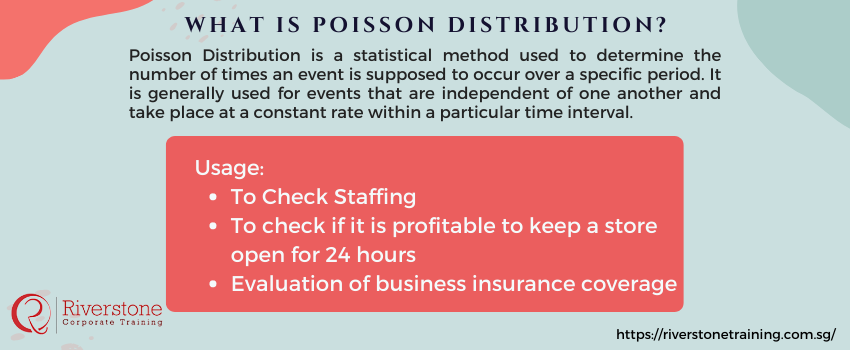
What is Poisson Distribution?
Poisson Distribution is a statistical method used to determine the number of times an event is supposed to occur over a specific period. It is generally used for events that are independent of one another and take place at a constant rate within a particular time interval. Poisson Distribution helps in finding the probability of an incident from occurring when you have the information about the number of times the event has already occurred. It is used as a discreet function, which means an event can only be considered either occurring or non-occurring, implying that the variable can only be measured in whole numbers.
This method was named after the mathematician Simeon Dennis Poisson.
Explanation of the process:
A Poisson distribution is used to determine the probability of an event happening an “X” or “Y” number of times, where a variable is a whole number and not a fraction. This system is applied in businesses to dictate an optimal scheduling system.
Practical Uses of Poisson Distribution with Examples:
Poisson Distribution is used mostly for businesses. As an example, is a video store that sells 200 videos on an average day, you can use the Poisson Distribution to determine the days when the store will sell more books than normal. Similarly, by observing the number of products sold on weekends, one can determine (using the Poisson Distribution) the number of days more products will be sold than the average number.
One of the most popular historical uses of Poisson Distribution was to calculate the annual number of Prussian soldiers killed by horse kicks. It can also be used in the modern era to calculate the probable number of car crashes in a certain area within a specified duration. Even in physiology, this is used to calculate the probable frequencies of neurotransmitter secretions.
How is Poisson Distribution Used in business?
Poisson Distribution is mostly used for business ventures. Here are some of the most common ways in which it is used:
- To Check Staffing: In a customer service center, this process can be used to check adequate staffing. To calculate that, one has to note down the number of calls received by the customer service center in an hour that takes more than ten minutes to resolve. Then, one can use the Poisson Distribution to find out the probable number of calls that might come in an hour, requiring more than ten minutes to resolve. With this new information, one can determine if the staffing at the customer service center is adequate or not to handle the calls.
- To check if it is profitable to keep a store open for 24 hours: To do this, one has to note down the number of sales made during an overnight shift of the store, generally from midnight till 8 A.M the next morning. Then, using the Poisson Distribution Formula, one can determine the probable number of sales one can make during an overnight shift, along with the lowest number of sales. Finally, one can calculate if the lowest quantity of sales is enough to pay the bills, mortgages, and other debts, to determine if keeping the store open for 24 hours is the right choice or not.
- Evaluation of business insurance coverage: Poison Distribution can be successfully used to review and evaluate business insurance coverage. Using this formula, one can determine the maximum and the minimum number of claims that might be reasonably filed in a single year, after noting down the average. This can help in reviewing the cost and the coverage of the insurance, and if it is beneficial for your business.
How Poisson Distribution Enhances Financial Risk Management:
Poisson Distribution is one of the tools you cannot miss in financial risk management, it is also strong framework used in measuring probability of occurrence of rare and discrete events, which threatens the stability of finance. It’s frequently applied to model operational risks such as the number of system failures, fraudulent transactions, or unexpected insurance claims within a given period. Through proper calculation of chances of such events, financial institutions have a better approach to allocating funds in case of losses, in regard to controls over reserves, and other possible contingencies. Professionals who have taken the best risk management course in Singapore for finance professionals are often well-versed in using Poisson models for such applications. The realization of Poisson probabilities enables forward risk-reducing measures to be taken and in the long run, profitability has been secured and regulatory needs met even in a turbulent financial environment, especially when paired with techniques from an advanced financial modeling course in Singapore with certification.
Using Poisson Distribution for Predicting Customer Behavior in E-commerce:
The Poisson Distribution can be used by e-commerce businesses, as it provides useful information on how to forecast the customer behavior and to streamline the operations. It’s particularly effective for forecasting the number of customer arrivals on a website, daily purchase frequencies, or even the volume of customer service inquiries. When historical data is analyzed in terms of a Poisson process, businesses will have the ability to predict the time when the demand will be at its peak, so that they will have enough servers and customer support personnel onboard. Such a predictive ability allows to have more specific management of stock and delivery, specific marketing, and customer experience. Conclusively, using Poisson Distribution can enable e-commerce companies to be more efficient, minimize cost, and increase general satisfaction of customers, which will generate sales. This is especially beneficial when aligned with a solid understanding of what is an e-commerce business model in Singapore, helping local firms tailor predictive strategies to their chosen framework. In addition, owners who take a business valuation course in Singapore for business owners can better interpret the impact of customer behavior patterns on long-term company value.


